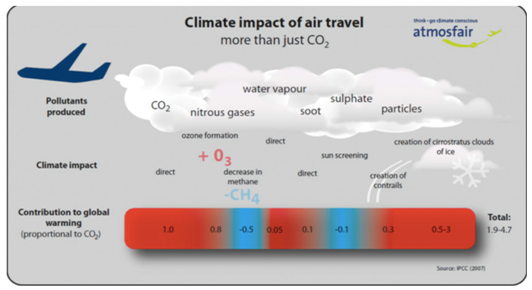Why in News?
- Last week, France announced a ban on all short-haul domestic flights.
- A month earlier, the Schiphol airport in Amsterdam, one of the busiest in Europe, banned private jets and small business planes.
- There is a growing clamour in Europe for a bigger crackdown on private aviation sector.
What’s in Today’s Article?
- Context (Aviation Ban in France)
- CO2 Emissions from Aviation Sector (Data, Role of Private Jets, Pollutants involved, etc.)
- Challenges and Solution w.r.t. Emissions from Aviation Sector
Context (Aviation Ban in France):
- France, last week, became the first country in the world to impose a ban on short-haul domestic flights.
- The country brought in a new law, effective from May 23, that bars air travel to destinations that can be covered by up to two-and-a-half hour journey by train.
- There is growing demand for a wider crackdown on private aviation.
- Apart from France, the Netherlands, Austria and Ireland urged the European Union to strengthen regulations to discourage travel by private jets in order to reduce CO2 emissions from aviation industry.
CO2 Emissions from Aviation Industry:
- In 1960, 100 million passengers travelled by air, at the time a relatively expensive mode of transportation available only to a small fraction of the public.
- By 2019, the total annual world-wide passenger count was 4.56 billion.
- In 2021 aviation accounted for over 2% of global energy-related CO2 emissions, having grown faster in recent decades than road, rail or shipping.
- As it stands, the aviation sector produces 900 million CO2 per year, according to International Air Transport Association (IATA).
- By 2050, if nothing is done to reduce the industry’s carbon footprint, that will rise to 1.8 billion tons.
- Reducing this level to gradually achieve net zero emissions in 2050 poses an enormous technological challenge that the IATA estimates will cost companies around USD 1.55 trillion between 2020 and 2050.
Contribution of Private Jets in CO2 Emissions:
- Private jets, usually far more inefficient than large commercial airliners, have always been a big eyesore from the climate perspective.
- In a recent report, it was found that private jets were 5 to 14 times more polluting, per passenger, than commercial planes, and 50 times more polluting than trains.
- It said private planes could emitting about 2 tonnes of carbon dioxide every hour, while an average person in Europe emits about 8.2 tonnes of carbon dioxide equivalent in an entire year.
Impact of Emissions from Airplanes:

- CO2 is the largest component of aircraft emissions, accounting for approximately 70 percent of the exhaust.
- After being emitted, 30 percent of a given quantity of the gas is removed from the atmosphere naturally over 30 years, an additional 50 percent disappears within a few hundred years, and the remaining 20 percent stays in the atmosphere for thousands of years.
- Water vapor is also a product of jet fuel consumption, making up about 30 percent of the exhaust.
- With its short lifespan in the atmosphere as part of the water cycle, water vapor from aircraft has a minimal direct warming impact.
- However, its presence in the exhaust plume has an indirect impact by contributing to the formation of contrails.
- All the remaining emissions in the graphic make up less than one percent of the exhaust plume.
What is the Solution to Reduce CO2 Emissions from Aviation Industry?
- IATA says that the main solution lies in the use of sustainable aviation fuels (SAF).
- These fuels – made from biomass, waste oils and could even be made from carbon capture in future – have the advantage that they can be used directly in existing aircraft.
- Such fuel sources can reduce CO2 emissions by 80 percent compared to kerosene over their entire life cycle.
- Two leading plane manufacturing corporations, Airbus and Boeing, have pledged that their fleets will be able to fly 100 percent on SAF by 2030.
Challenges Associated with SAF:
- Currently, SAF accounts for only 0.1 percent of aviation fuel.
- Encouraged by governments, the infrastructure to produce SAF is being set up in the US and Europe, but is still embryonic – and the cheapest fuel that comes out costs four time more than kerosene.
Offset Mechanism for Reducing Emissions from Aviation Industry:
- In 2016, the International Civil Aviation Organisation (ICAO) put in place an offset mechanism to ensure that any increase in emissions over 2020 levels is compensated for by the airline industry through investment in carbon saving projects elsewhere.
- Called Carbon Offsetting and Reduction Scheme for International Aviation, or CORSIA, the offset plan is supposed to run from 2021 to 2035.
- CORSIA is considered a breakthrough, but it is not very ambitious. It only seeks to offset emissions that are over and above 2020 levels. It does not deal with total emissions.
Conclusion:
- Reducing aviation emissions through other means has not proved to be easy.
- Unlike road or rail travel, aviation does not have viable technology alternatives for shifting to cleaner fuels.
- Biofuels have been tried and so have hydrogen fuel cells. Solar powered planes have also made trips.
- But use of these alternative fuels for flying large commercial airliners is still some distance away.









